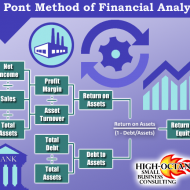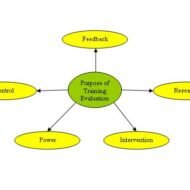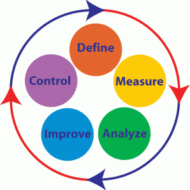Posted by Managementguru in Management Accounting
on Mar 24th, 2015 | 0 comments

What are the advantages and limitations of ratio analysis? Advantages: It is an important and useful tool to determine the efficiency with which working capital is being managed in a business organization. It is a ‘health test‘ for a business firm in that it can gauge whether the firm is financially healthy or not. It aids the management of business concern in evaluating its financial position and performance efficiency. It clearly shows the trend of changes in the market position (upward, downward or static), as it covers a number of previous accounting (financial) periods. The progress or downfall of a firm is clearly indicated by this analysis. It assists in preparing financial estimates for the future (financial forecasting). It facilitates the task of managerial control to a great extent. It helps the credit suppliers and investors in deciding upon a business firm as a potential investment outlet or desirable debtor. Ideal or Standard ratios can be established which can be used as reference points of comparison for a firm’s progress over a period of time. It communicates important information with relation to financial strength, earning capacity, debt (borrowing) capacity, liquidity position, capacity to meet fixed commitments, solvency, capital gearing, working capital management, future prospects etc. of a business concern. This analysis is also useful for bench marking purpose- to compare the working result and efficiency of performance of a business enterprise with that of other firms engaged in the same industry (inter-firm comparison). It helps the management to discharge their basic functions of planning, coordinating, controlling etc. It serves as an instrument for testing management efficiency too. It acts as a useful tool for deciding on certain policy matters. Limitations: Accounting ratios calculated based on ratio analysis will be correct only if the accounting data on which they are based are correct. It is only an analysis of past financial data. In certain cases ratio analysis might prove to be misleading with regard to profits. Continuous fluctuation in price levels ( or, purchasing power of money) seriously affect the validity or comparison of accounting ratios calculated for different accounting periods and make such comparisons very difficult. Comparisons become difficult also on account of difference in the definition of several financial (accounting) terms like gross profit, operating profit, net profit etc. There is lot of diversity in practice as regards to the measurement of ratios. Different firms use different accounting methods and the validity of comparison is severely affected by window dressing in the basic financial statements. A single ratio will not be able to convey much information. This analysis only gives part of the total information required for proper decision-making. This should not be taken as a substitute for sound judgement. It should not be overlooked that business problems cannot be solved mechanically through ratio analysis or other types of financial analysis. Follow ManagementGuru Net’s board Accounting – Financial and Management Accounting on...

Posted by Managementguru in Business Management, Change management, Human Resource, Training & Development
on Apr 25th, 2014 | 0 comments

The process of Training Programme Evaluation Evaluation of training programme is basically critical examination of appraisal of training programmers. Appraisal of training programme is necessary for improvement and evaluation is a continuous process. “Learning from mistakes” and transforming them into experience and knowledge is the crux of training evaluation. Areas of Evaluation: The participant’s opinion about the programme Knowledge, attitude, skills learned during the training sessions Behavioral change, if any, as a result of training Pay off and benefits that accrue to the organization resulting from the change in behavior of the trainees. What should the evaluation process consider in the planning stage? Attributes of training programme to be evaluated Standard for evaluation Measuring various aspects of the programme and feedback on the effectiveness of the same Implementation of the programme results Scrutinizing the changes that need to be done in the training session Method of dealing with the change – Who will do it, how will the changes be made, how quickly the changes can be implemented. Steps in the Evaluation Process: Establish acceptable standards and bench marking Data collection Analysis of data, interpretation and drawing conclusions Feedback of the results 1. Establish acceptable standards Standards may be set in any one of the following methods; Setting standards through best practice Setting standards through bench marking 2. Data Collection Data may be collected using any one of the following techniques: Questionnaire Interview Written Test Observation 3. Analysis of Data and Interpretation Raw data should be tabulated – Histogram and frequency distribution yield basic information on the shape of dispersal of data around the mean and standard deviation. Relevant statistical tools must be employed depending upon the purpose of evaluation. 4. Evaluating and Feedback The steps involved in this process are: Design valuation – Includes clear objectives backed up by proper content Evaluation of content – Value and usefulness of the programme content may be measured by seeing the reaction of the trainees. An animated discussion in the classroom is a clear indication of the value the content offers. Usefulness may be known by interviewing the trainees and by comparing the performance impact of training with individual job descriptions. Evaluating the presenters – By taking feedback from the trainees the training quality of the presenter or lecturer may be evaluated. Evaluation of trainees – Three aspects that have to be considered on the part of the trainees are, feeling and opinion, learning and attitudinal changes. Evaluating on the job results and productivity changes – A number of factors affect productivity and pre and post measurement of some of the below mentioned aspects shall throw light on the effect of the training programme. Factors affecting Productivity: Cost Reduction ,grievance reduction, productivity after versus before training, work quality, quantitative results, accident rates, absenteeism, employee suggestions, supervisory rating, profits, sales volume, turnover rates, customer complaints, worker efficiency, training time required for proficiency, cost per untrained employee, new product development, new customers and public relations. Behavioral Factors: Some of the specific behavioral changes listed as follows can be observed before and after the training programme – application of new knowledge, use of new skills, high standards, courtesy, adherence to safety regulations, teamwork, perseverance, honesty, co-operation, quality of work, punctuality, effort, initiative. Useful Information: Sample Training Evaluation Questionnaire 5 evaluation methods to evaluate staff training...

Posted by Managementguru in Change management, Human Resource, Principles of Management, Project Management, TQM, Training & Development
on Mar 22nd, 2014 | 0 comments

Zero defect achievement – Striving towards perfection! What is TQM: Quality management is all about being proactive and concepts like total quality management and six sigma of recent origin reiterate the fact that hundred percent error free performance is possible the first time and every time. This is what is called as zero defect achievement which most of the companies at corporate level are headed for. The intention is to strive for perfection in work, the way an archer aims for the bull’s eye on a target. It is time for people to cast off their conservative and archaic business practices and think out of the box to enjoy a sustainable competitive advantage driven by quality. Zero defects seek top performance standards the first time and every time. Management scholars offer several suggestions to improve the zero defects programme: The idea of zero defects programme has to be communicated through out the organization right from the top to the bottom level including managers, supervisors and workers. This would harmonize the functions of line and staff. Prerequisites needed for the programme have to be determined and made available. The culture and climate of the firm should be conducive to accomplish the programme. Explain in simple terms about the functions to be accomplished. Design some solid system of recognition. Set up a time schedule as time lines are very important when it comes to product delivery. Spot all the bottlenecks and remove them. Training is absolutely essential– the skill set and mind set of the employees have to be attuned to the goals of the venture. Mock training and rehearsals are helpful. Standardization is the key to the success of this programme. Bench Marking: Total quality management is a process contributing towards quality and bench marking is a means to achieve high quality performance by setting some top notch industry performers as reference points or standards. It is a continuous systematic process employed by a business enterprise to develop business and working processes that integrate the best practices available in the industry. Bench marking is a crucial element in the process of quality management. Quality is one field of production, which reflects the ethical viewpoint and approach of business firms towards the society and other investors or stakeholders. Bench marking is a modus operandi used to: Identify and define customer requirements Plan and establish effective goals and objectives Develop time measures of productivity Become more competitive Determine industry’s best practice The initial step is to decide what is to be bench marked-the product, services, customers or business processes in various departments. The second phase of action is to identify and select your competitors who will set the necessary precedence. With that as reference, decide on your company’s strategies by making meaningful and valid comparisons. Judge the competitor strengths and weaknesses and compare them with that of your own to get a clear picture of your current performance levels and capabilities. This will give you a clear indication on the action plans to be developed and implemented in a phased manner by your organization. Quality management is likely to happen only when all the employees of the organization work as a team with unified principles. Quality demands deep commitment and responsibility from the members of organizations. It calls for intense training to imprint the perception of quality in the minds of...






